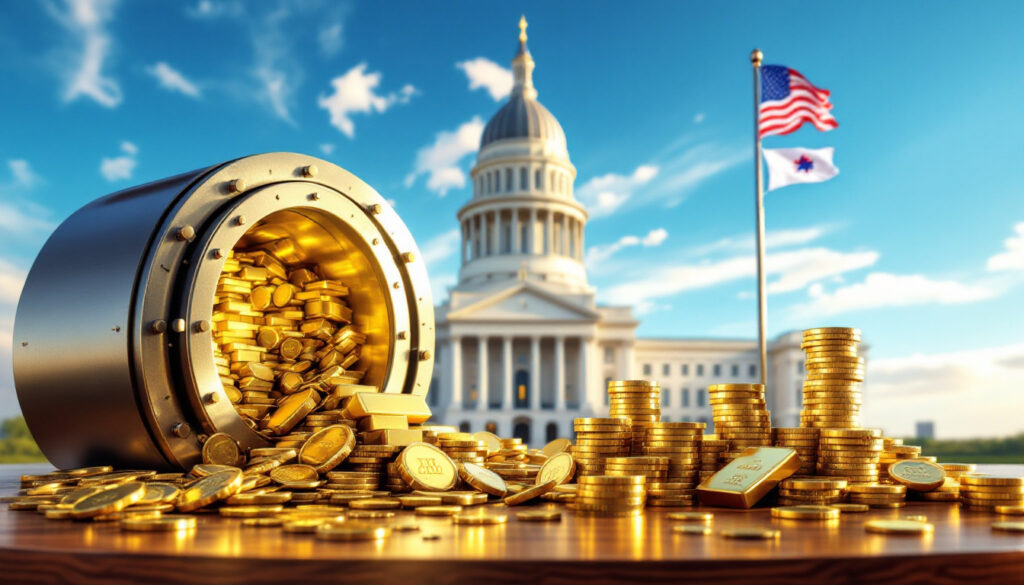What Happened to North Dakota's Sound Money Bill?
In a significant setback for sound money advocates, North Dakota's House Bill 1183 was decisively voted down in the state Senate by a margin of 34-13. The legislation, championed by Representative Daniel Johnson, would have required the state treasurer to allocate approximately $70 million (1% of the state treasury) to physical gold and silver bullion as a hedge against inflation and currency devaluation.
Senator Jerry Klene emerged as one of the bill's most vocal critics, arguing that the state treasurer's role is "just handling the checkbook…not making investments." This perspective reflects a fundamental misunderstanding about the nature of precious metals in a monetary system – viewing them as speculative investments rather than wealth preservation tools.
Other opposition centered on practical concerns. The Bank of North Dakota estimated needing approximately $2 million to renovate its vault facilities to accommodate the physical bullion, which officials noted "could weigh in the tons." This logistical challenge became a talking point for those opposing the measure, despite similar hurdles being successfully overcome in states like Texas and Oklahoma.
Senator Dale Patton emphasized that gold ETF strategies were not included in North Dakota's comprehensive investment plan, suggesting the proposal deviated from established financial protocols. This reasoning, however, overlooked the distinct purpose of sound money holdings compared to traditional investments.
While North Dakota's attempt failed, the legislative defeat provides valuable lessons for sound money advocates in other states. Similar bills in Kentucky and New Jersey initially faced opposition but ultimately succeeded after addressing storage solutions and clarifying the wealth preservation (rather than investment) nature of precious metals holdings.
Understanding Sound Money: Gold vs. Fiat Currency
Sound money refers to currency that maintains intrinsic value over time and resists manipulation by political or monetary policy. For thousands of years, gold and silver have served this function due to their scarcity, divisibility, durability, and universal recognition of value – qualities that make them ideal monetary instruments.
The U.S. Constitution explicitly acknowledges this monetary role in Article 1, Section 10, which establishes gold and silver as legal tender. This constitutional foundation reflects the Founders' understanding of history's lessons regarding currency debasement and inflation.
In contrast, fiat currency (like today's U.S. dollar) derives its value solely from government decree and the public's acceptance. Unlike precious metals, fiat money can be created through printing or digital creation without corresponding production of goods or services. The Federal Reserve's balance sheet expansion to $8.8 trillion post-2020 illustrates this phenomenon.
According to official government targets, the U.S. dollar loses approximately 2-3% of its purchasing power annually through intentional inflation. However, this rate accelerated dramatically to around 9% during 2022-2023 based on official measurements, with some alternative calculations suggesting even higher figures.
Representative Johnson succinctly captured this relationship during legislative hearings: "Gold appreciates as the dollar loses value." This observation highlights the inverse relationship between fiat currency and precious metals that makes the latter valuable as monetary insurance.
The historical record supports this perspective. While fiat currencies throughout history have eventually returned to their intrinsic value (zero), gold has maintained relatively stable purchasing power for centuries. An ounce of gold that could purchase a fine men's suit in 1920 can still purchase a fine men's suit today – a preservation of value no fiat currency can match over similar timeframes.
Wealth Preservation vs. Investment: A Critical Distinction
The North Dakota legislative debate revealed a critical misunderstanding that plagues many sound money discussions: the confusion between investments and wealth preservation tools. Senator Klene's statement that "You don't convert [gold] monthly to pay bills" portrayed precious metals as impractical investments rather than monetary insurance.
This fundamental misconception frames the debate incorrectly. Gold and silver should not be evaluated using traditional investment metrics like yield, dividend payments, or quarterly returns. Instead, they function more like insurance policies against currency devaluation, banking system fragility, and monetary policy failures.
Despite this distinction, precious metals have performed remarkably well even when inappropriately measured as investments. Gold has outperformed the S&P 500 in seven of ten recessionary periods since 1970, including a 25% rise during the 2008 financial crisis when equities plummeted by 38%. Over certain extended timeframes, gold has even delivered superior returns to stocks while exhibiting lower volatility (12% annualized compared to equities' 18%).
For state treasuries, this performance characteristic offers a compelling additional benefit beyond wealth preservation. During periods of economic stress – precisely when state tax revenues typically decline – gold as a hedge often appreciates, potentially providing counter-cyclical budget relief.
Financial advisors typically recommend allocating 5-15% of a portfolio to precious metals for crisis hedging. This modest allocation acknowledges gold's complementary role alongside traditional investments rather than as a replacement for them.
When considering precious metals, investors should understand that silver typically exhibits greater volatility than gold, with annual price swings averaging 22% compared to gold's 12%. This volatility reflects silver's dual role as both a monetary and industrial metal, with approximately 50% of demand coming from manufacturing applications.
How Other States Are Approaching Sound Money
Despite North Dakota's setback, sound money initiatives continue gaining momentum across America. Currently, 42 states have enacted legislation exempting gold and silver from capital gains taxes, effectively recognizing their monetary rather than investment nature.
Texas established the most ambitious state-level program in 2015 with the Texas Bullion Depository, which now holds approximately $1 billion in gold reserves. This $23 million facility generates approximately $2.5 million in annual storage revenue while providing Texans secure storage options outside the traditional banking system.
Oklahoma followed suit in 2023 with its own state depository initiative, while Utah pioneered legal tender legislation recognizing gold and silver as money within state borders. Utah has recently expanded its approach with a 2024 pilot program for gold-backed municipal bonds, potentially offering communities inflation-protected infrastructure financing.
Wyoming has taken perhaps the most innovative approach, with legislators developing a 2026 proposal for gold-backed cryptocurrency that would combine sound money principles with modern technological efficiency. This blockchain integration could reduce storage and logistics costs by approximately 40% compared to traditional physical bullion systems.
These state-level initiatives reflect growing global trends. As Representative Johnson noted during hearings, "Nations are diversifying from the dollar" – an observation supported by gold market analysis showing central bank gold purchasing reaching record levels in 2023. Poland's 2024 repatriation of 100 tons of gold from the Bank of England exemplifies this international shift toward monetary sovereignty and inflation protection.
What Does This Mean for Individual Savers?
While sound money legislation affects state treasuries directly, the implications for individual savers are equally significant. With average savings account yields hovering around 0.5% compared to inflation exceeding 5% (as of 2025), most Americans are losing purchasing power by maintaining traditional cash savings. This reality makes sound money principles relevant to personal finance.
Individuals seeking inflation protection might consider:
-
Allocating 5-15% of savings to physical precious metals as monetary insurance
-
Understanding the higher volatility of silver (22% annual price movements) compared to gold (12%)
-
Evaluating storage options ranging from home safes to private vaults or state depositories where available
-
Considering premium differences between various forms (coins typically command 3-8% premiums over spot for gold and 10-25% for silver)
The situation in Argentina provides a cautionary example of why such preparations matter. Facing 140% inflation in 2024, Argentine citizens rapidly shifted toward stablecoins and precious metals to preserve purchasing power – options that proved far more effective than government bonds or bank deposits.
For everyday transactions, paper currency maintains superior liquidity, with the U.S. dollar's daily trading volume approaching $6.6 trillion compared to gold's $130 billion. This advantage makes fiat currency appropriate for short-term needs while precious metals better serve medium and long-term savings goals.
Digital gold tokens like PAX Gold offer an emerging middle ground, combining gold's preservation qualities with cryptocurrency's liquidity advantages. These instruments allow ownership of allocated physical gold while enabling easy transfer and divisibility for smaller transactions.
FAQs About Sound Money Initiatives
What is the primary goal of sound money legislation?
Sound money legislation aims to protect state funds and citizens from currency devaluation by establishing alternative forms of money that maintain purchasing power over time. Unlike traditional investments seeking maximum returns, sound money initiatives focus on capital preservation and monetary stability.
Why do some states want to invest in gold and silver?
States seek to diversify their treasury holdings beyond dollar-denominated assets to protect against inflation and currency risks. As the Federal Reserve continues expansionary monetary policies, many state treasurers view precious metals as insurance against potential purchasing power erosion of taxpayer funds.
How does sound money benefit average citizens?
Sound money initiatives can protect citizens' purchasing power by providing alternatives to inflation-prone currencies. States that recognize gold and silver as legal tender typically eliminate sales taxes on precious metals transactions, reducing acquisition costs. State depositories may also offer secure storage options with lower fees than commercial alternatives.
What obstacles do sound money initiatives face?
Common obstacles include storage logistics, security concerns, implementation costs, political opposition, and fundamental misunderstandings about precious metals' monetary role. Many legislators, like those in North Dakota, incorrectly evaluate gold and silver using investment metrics rather than wealth preservation frameworks.
The Path Forward for Sound Money Advocates
The North Dakota experience highlights the educational challenge facing sound money advocates. A 2025 poll showed 63% of North Dakota voters actually favor treasury metals allocation, suggesting the legislative defeat stemmed more from official misunderstanding than public opposition.
To address these misconceptions, advocates must clearly articulate the distinction between investments and wealth preservation tools. Constitutional scholars supportive of sound money initiatives emphasize that "States have authority to define legal tender" – a legal foundation that strengthens the case for state-level monetary reforms.
Implementation concerns like storage logistics require practical solutions. Blockchain technology offers promising options, potentially reducing physical storage costs by 40% through tokenization while maintaining allocated ownership of physical metals. Such innovations address the logistical hurdles cited by North Dakota officials.
Arizona's failed 2023 sound money referendum provides valuable lessons for future campaigns. The proposal's defeat stemmed primarily from confusion about its purpose and mechanics – issues that could be addressed through clearer educational materials and phased implementation approaches.
The declining dollar insights from organizations like the Heritage Foundation have developed comprehensive briefs on state monetary sovereignty that provide roadmaps for effective legislation. These resources emphasize starting with modest allocations (0.5% rather than 1%) and phased implementation to demonstrate viability before expansion.
For North Dakota specifically, sound money advocates might consider revising their approach to focus on the state's $7 billion legacy fund rather than general operating funds. This sovereign wealth fund's long-term horizon aligns perfectly with precious metals' wealth preservation characteristics.
As currency devaluation continues and gold market outlook 2025 suggests growing monetary uncertainty, the case for sound money will likely strengthen. States that establish sound money frameworks now position themselves advantageously for the financial challenges ahead, while providing their citizens with valuable options for preserving their own wealth against the erosion of purchasing power.
Ready to Stay Ahead of Major Mining Discoveries?
Discover how significant mineral discoveries can lead to substantial market returns by exploring Discovery Alert's dedicated discoveries page, where their proprietary Discovery IQ model transforms complex ASX announcements into actionable investment insights for traders and long-term investors alike.




